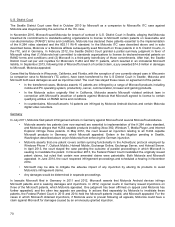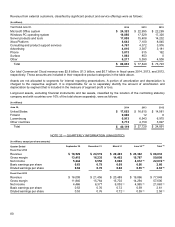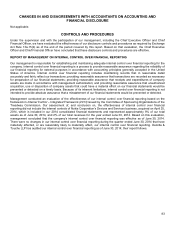Microsoft 2014 Annual Report Download - page 78
Download and view the complete annual report
Please find page 78 of the 2014 Microsoft annual report below. You can navigate through the pages in the report by either clicking on the pages listed below, or by using the keyword search tool below to find specific information within the annual report.77
Our reportable segments are described below.
Devices and Consumer
Our D&C segments develop, manufacture, market, and support products and services designed to entertain and connect
people, increase personal productivity, help people simplify tasks and make more informed decisions online, and help
advertisers connect with audiences. Our D&C segments are:
• D&C Licensing, comprising: Windows, including all OEM licensing (“Windows OEM”) and other non-volume
licensing and academic volume licensing of the Windows operating system and related software; non-volume
licensing of Microsoft Office, comprising the core Office product set, for consumers (“Office Consumer”);
Windows Phone operating system, including related patent licensing; and certain other patent licensing
revenue;
• Computing and Gaming Hardware, comprising: Xbox gaming and entertainment consoles and accessories,
second-party and third-party video game royalties, and Xbox Live subscriptions (“Xbox Platform”); Surface
devices and accessories; and Microsoft PC accessories;
• Phone Hardware, comprising: Lumia Smartphones and other non-Lumia phones, beginning with the
acquisition of NDS; and
• D&C Other, comprising: Resale, including Windows Store, Xbox Live transactions, and Windows Phone Store;
search advertising; display advertising; Office 365 Consumer, comprising Office 365 Home and Office 365
Personal; Studios, comprising first-party video games; our retail stores; and certain other consumer products
and services not included in the categories above.
Commercial
Our Commercial segments develop, market, and support software and services designed to increase individual, team,
and organizational productivity and efficiency, including simplifying everyday tasks through seamless operations across
the user’s hardware and software. Our Commercial segments are:
• Commercial Licensing, comprising: server products, including Windows Server, Microsoft SQL Server, Visual
Studio, System Center, and related Client Access Licenses (“CALs”); Windows Embedded; volume licensing of
the Windows operating system, excluding academic (“Windows Commercial”); Microsoft Office for business,
including Office, Exchange, SharePoint, Lync, and related CALs (“Office Commercial”); Microsoft Dynamics
business solutions, excluding Dynamics CRM Online; and Skype; and
• Commercial Other, comprising: Enterprise Services, including Premier Support Services and Microsoft
Consulting Services; Commercial Cloud, comprising Office 365 Commercial, other Microsoft Office online
offerings, Dynamics CRM Online, and Microsoft Azure; and certain other commercial products and online
services not included in the categories above.
Revenue and cost of revenue are generally directly attributed to our segments. Certain revenue contracts are allocated
among the segments based on the relative value of the underlying products and services. Cost of revenue is directly
charged to our hardware segments. For the remaining segments, cost of revenue is directly charged in most cases and
allocated in certain cases, generally using a relative revenue methodology.
We do not allocate operating expenses to our segments. Rather, we allocate them to our two segment groups, Devices
and Consumer and Commercial. Due to the integrated structure of our business, allocations of expenses are made in
certain cases to incent cross-collaboration among our segment groups so that a segment group is not solely burdened by
the cost of a mutually beneficial activity as we seek to deliver seamless experiences across devices, whether on-premises
or in the cloud.
Operating expenses are attributed to our segment groups as follows:
• Sales and marketing expenses are primarily recorded directly to each segment group based on identified
customer segment.
• Research and development expenses are primarily shared across the segment groups based on relative gross
margin but are mapped directly in certain cases where the value of the expense only accrues to that segment
group.
• General and administrative expenses are primarily allocated based on relative gross margin.
























